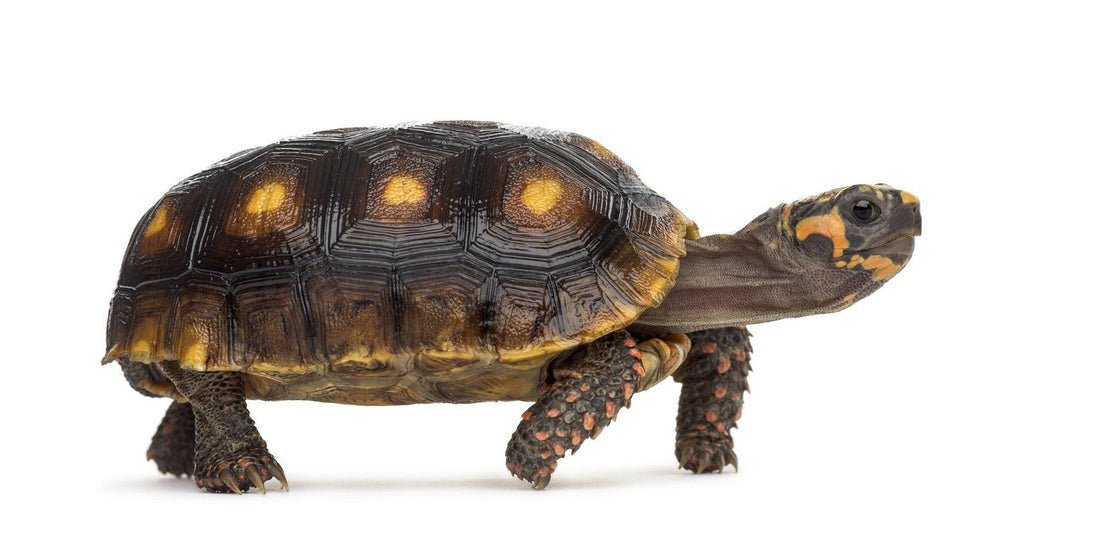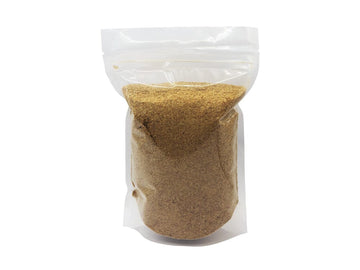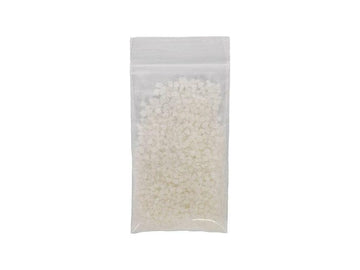Red-footed tortoises (Chelonoidis carbonarius) are a 12-18” long species of tortoise native to South America. They can be found in heavily forested, humid habitats, as well as sometimes in savanna areas.
Red-footed tortoises generally have a dark brown or black-brown shell, with a pale spot on each scute, and a pale to dark yellow plastron. Most notably, they have yellow to red-orange scales on their limbs and tail. Females are generally rectangular in shape, while males are pinched in the middle, giving them an hourglass-like appearance.
Red-footed tortoises are one of the most common pet tortoises in the US. With good care, they are capable of living 50+ years!
Minimum terrarium size for red-footed tortoises
The minimum size enclosure we recommend for a red-footed tortoise is 24 sq feet of floor space, or about 6' x 4'. However, if you are able to go larger that is ideal! Because they need high levels of humidity, it’s best to avoid using an open enclosure like a tortoise table if housing them indoors.
Cohabitation (housing multiple red-footed tortoises in one enclosure) is optional. They are generally not bothered by it, and it may even be beneficial. You will need to add about 16 square feet of extra floor space for each additional tortoise after the first two two. However, if you only want one tortoise, that’s fine too!
Do red-footed tortoises need UVB?
Yes, they do require UVB. The best UVB bulbs for red-footed tortoises are:
- Arcadia T5 HO 12% Kit
- Zoo Med T5 HO Reptisun with 10.0 bulb
If you use the Reptisun UVB, it should be placed 6-8” above the top of the tortoise’s shell in the basking area. Bulbs mounted in the Arcadia ProT5 fixture can be placed a bit further away: 15-24” above the tortoise’s shell.
Your UVB bulb and fixture should be roughly half the length of the tortoise’s enclosure. Most people follow a 12 hour on and 12 hour off schedule, but you can also choose to follow the sun. If you want more hours on in the summer and more hours off in the winter, that is also beneficial. However, if your tortoise is housed outdoors and has access to sunlight, you will not need a UVB lamp.
Since red-footed tortoises need such large enclosures, indoor enclosures may need more illumination than just a UVB bulb can provide. You can consider a 6500K LED or T5 HO fluorescent grow light for this purpose. These are also great for live plants!
Best temperature for red-footed tortoises
We suggest a basking temperature between 90°F-95°F. On the other side of the enclosure, the temperature can be between 75°F-80°F. Basking temperatures and surface temperatures are best measured with a temperature gun. Ambient temperatures can be measured with a digital probe thermometer.
Since this is a larger tortoise species, we recommend at least two halogen flood heat bulbs placed close together over the basking area to evenly heat the tortoise’s entire body. You want heat lamps to be at least 8” away from the top of your tortoise’s shell to avoid burns. We do not recommend ceramic heat emitters (CHEs), red bulbs, or blue bulbs, as these are not as effective. The wattage you choose may take some trial and error, if the heat is too high you can use a rheostat or dimmer to lower the temperature of the bulbs.
Best humidity levels for red-footed tortoises
We recommend an average humidity of 70-80% for your tortoise. You can provide a humid hide on the cool side, lined with moistened sphagnum moss. Humidity can be measured via digital probe hygrometer.
Humidity can be increased by misting the enclosure 2-3x/day with a spray bottle. You can mist first thing in the morning and then again at night if needed. Mixing water directly into the substrate also helps with maintaining high humidity.
Best substrate for red-footed tortoises
Providing a thick layer of naturalistic substrate (“bedding”) will help maintain correct humidity levels and also provide something for your tortoise to dig in as desired. We recommend the following substrates for red-footed tortoises:
- Zoo Med Forest Floor
- Zoo Med ReptiSoil
- Exo Terra Plantation Soil
- Zilla Jungle Mix
Layering clean, chemical-free leaf litter on top of the substrate will also help with humidity.
Substrate should be at least 4-6” deep and completely replaced every 3-4 months. Remove poop and urates daily, along with contaminated substrate.
How to decorate a red-footed tortoise terrarium
An empty terrarium makes for a bored tortoise, reducing its quality of life. Keep your pet entertained and engaged with its environment with the strategic use of décor items that encourage it to exercise natural behaviors!
Here are some ideas to get you started:
- additional hiding places/burrows
- large hollow logs
- live, edible plants
- large, flat stones
The more stuff you add, the more functional your enclosure is likely to become!
What to feed to a red-footed tortoise
Red-footed tortoises are omnivorous, which means that they need both plant- and animal-based foods in order to get the right nutrition. For best health, we suggest a balance of 15% fruit, 70% greens/veggies/flowers/weeds, and <15% low-fat animal protein.
Safe fruits for red-footed tortoises: apples, berries, melons, papaya, guava, pineapple, bananas, cactus fruit, grapes, plums, peaches
Safe vegetables for red-footed tortoises: cactus pads, kale, collard greens, turnip greens, mustard greens, dandelion greens + flowers, watercress, broccoli, escarole, swiss chard, parsley, endive, romaine lettuce, hibiscus leaves + flowers, nasturtium, honeysuckle
Protein sources for red-footed tortoises: nightcrawlers, mealworms, crickets, dubia roaches, young pre-killed feeder mice, silkworms, hornworms, black soldier fly larvae.
Tortoises younger than 5 years should be fed daily, while those older than 5 years can be fed every other day.
Supplements
You will also need calcium and vitamin supplements to prevent your tortoise from developing a potential deficiency. We recommend Repashy Calcium Plus LoD, lightly dusted on each meal. A little bit of Mazuri tortoise diet also makes a nutritious addition.
Water
Of course, don’t forget a water bowl! Red-footed tortoises like to soak, so you will want a shallow “puddle” of water for them to soak and defecate in (cat litter trays work well for this) as well as a smaller water bowl for them to drink from. Change the water daily and scrub the dishes weekly with a reptile-safe disinfectant, or whenever it becomes soiled.
How to handle your red-footed tortoise
Reptiles generally don’t appreciate petting and handling in the same way that dogs and cats do. That being said, red-footed tortoises are considered more social and generally tolerate human interaction pretty well! If you have to pick up your tortoise, be gentle and try to pick it up from the side or below rather than from above. They tend to appreciate gentle scratches and receiving treats.
*This care sheet contains only very basic information. Although it’s a good introduction, please further your research with high-quality sources. The more you know, the better you will be able to care for your pet!












2 comments
Hi Alyssa — As omnivores, red-footed tortoises can certainly eat dubia nymphs, but the greatest difficulty for your tortoise is going to be catching them. As long as you corral them into an escape-proof feeding dish, however, that shouldn’t be a problem!
Can I feed my 2 year old red footed tortoise live Dubia nymphs?